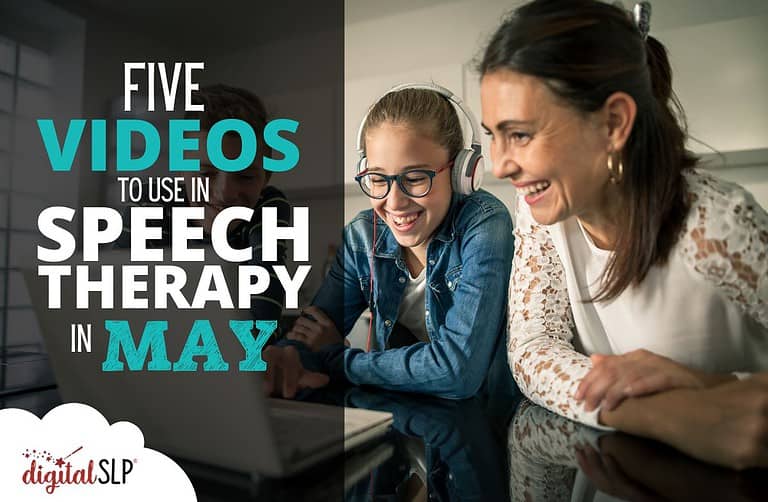This post contains affiliate links for which we may receive compensation at no additional cost to you. Click here to read our full affiliate policy.
May is on its way, bringing plenty to celebrate! This month’s video recommendations will help you do just that, whether you’re highlighting mothers, mental health, or museums.
Just a quick reminder: I watched all of these videos and found them to be worthwhile, but everyone’s needs are different, so please preview any video before sharing it with students.
Let’s explore these recommendations!
Length: 5 minutes
Ages: Kindergarten–5th grade
This video features an enthusiastic read aloud of Andrea Wang’s poignant (and multi-award-winning) picture book Watercress, making it an impactful choice to honor Asian American, Native Hawaiian and Pacific Islander Heritage Month. Watercress tackles heavy themes in an accessible way, and it could inspire discussions about identity, family, and memory.
Try pairing Watercress with these speech therapy targets:
- Adjectives: With compelling descriptors like “glinting,” “abrupt,” and “stringy,” Watercress has vivid examples for students who understand the basics of describing, but want to give their adjectives more oomph.
- Similes: Wang’s similes (e.g., “Mom’s eyes are as sharp as the tip of a dragon’s claw”) are powerful and inventive–an ideal way for students to begin learning about figurative language.
- Synonyms: Many children’s books work well to inspire synonym generation, but it’s less common for them to provide clear synonym models. Watercress is an exception! The narrator describes “. . . the soggy bag, my sopping shirt, our sodden selves . . . ” and provides the perfect opportunity to introduce synonyms.
- Personal narrative: This book is a personal narrative in disguise! After students listen to the narrator’s story, they could use it as a guide for structuring their own.
- Extension: Watercress is available at many grocery stores, and students may be curious about it after watching this video. Why not make a speech salad? Or, if your students aren’t into leafy greens, they could learn about and describe the thoughtful art that illustrator Jason Chin created for this beautiful book.
Length: 8 minutes
Ages: 9th–12th grade
National Stuttering Awareness Week is observed during the second week of May, and this bold video asks us to consider the role of the listener in conversations with people who stutter—which is, as the filmmaker states, “to fill in the gaps with patience.” Students who stutter may find it liberating, their peers may find it challenging, and SLPs may find themselves inspired to change their approach to stuttering treatment. Don’t miss this one!
Make the most of this powerful short film with these ideas:
- Advocacy: This video isn’t just for students! It could also give colleagues, parents, and other SLPs valuable insight into the lived experience of stuttering, especially when paired with the accompanying resources from The New York Times.
- Discussion: Students could talk about whether or not they agree with the film’s central message, and share the reasons behind their answers.
- Emotions: Students could make inferences about the emotions that John Hendrickson (who is featured in the video) experienced at various points during the film.
- Secondary behaviors: Students who aren’t yet comfortable exploring their own stuttering could discuss what they notice in the video, especially when it comes to any secondary behaviors.
- Extension: John Hendrickson’s work was featured in a Digital SLP podcast episode in early 2024, and he was interviewed on ASHA Voices. His memoir Life on Delay is also a tremendous resource. (Disclaimer: it includes mature subject matter, so I recommend caution if you share excerpts with students).
Length: 2 minutes
Ages: Any!
Sometimes you just need to giggle, and this quick video is here to help! It stars Bosco, a London-based dachshund who isn’t satisfied with regular-sized sticks; he prefers trotting around with actual tree branches. Bosco could help you and your students celebrate National Pet Month, Be Kind to Animals Month, or National Rescue Dog Day (May 20th).
Laughter supports learning, so here are some skills to teach with this video:
- Describing/sequencing: You could mute the (minimal) sound on the video, and invite students to provide their own narration.
- Predicting: Not surprisingly, Bosco gets himself into some sticky (and stuck) situations. You could pause the video at various points and ask students to make inferences about what they think will happen next.
- Problem solving: You could also pause the video each time Bosco is in a predicament, and ask students how they think he should solve it.
- Perspective taking/Theory of Mind: Bosco’s face is incredibly expressive! Students could discuss what he might be thinking and feeling throughout the video.
- Extension: National Geographic Kids has many articles and videos devoted to pets, and students could research topics of interest and share their findings with each other.
Length: 3 minutes
Ages: 3rd–8th grade
May 18th is International Museum Day, and the magic of YouTube can bring the Metropolitan Museum of Art into your speech room! This video is from its wonderful #MetKids collection, and it features 11-year-old Xavier, who has some thoughtful questions for Ted, a conservator in the Department of Arms and Armor at the Met.
As students expand their art preservation knowledge, they could also work on:
- Career exploration: Students may be unfamiliar with careers in art conservation (I know I was!), but this video could pique their interest. If they want to learn more, the American Institute for Conservation is a great place to start.
- Compare/contrast: When asked if he knows of any sports that require ”armor,” Xavier cites hockey as an example. Students could compare and contrast sports padding and its uses with metal armor and its uses.
- Inferences: Early in the video, Ted tells Xavier that conservators try to “sneak up on the art” when they work. Students could guess the meaning behind this surprising phrase, and then watch the rest of the video to find out if they were correct.
- Wh-questions: Because this video is structured like an informal interview, it includes many examples of wh-questions (and answers).
- Extension: Students who are interested in exploring the Met’s armor collection may want to check out the department’s website for photos, articles, videos, and more.
Disclaimer: This video link was not compatible with Safe Share so it will take you directly to YouTube. Please be mindful of ads or other sensitive content that may appear on your screen after the video is shown.
Length: 3 minutes
Ages: Preschool–3rd grade
May is Mental Health Awareness Month, so there’s no better time to focus on providing an accepting space to be with big feelings! In this compassionate picture book, Eva Eland depicts sadness as a gentle blue creature and reminds us that it isn’t something to push away. In fact, it just wants to know it’s not alone.
In addition to providing an empowering mental health message, this video can also help students practice:
- Articulation: Any discussion about sadness is full of opportunities to work on initial /s/.
- Figurative language: This whole book is one big metaphor! It would work well as an introduction to figurative language, or students may want to brainstorm additional metaphors for different emotions.
- Personal narrative: Students could share about a time that they were sad, and what they did to work through it.
- Self-care/self-regulation strategies: Eland offers many ideas for being with sadness, including giving it a name, listening to it, and trying to find something that you both enjoy, like drawing, music, or drinking hot chocolate. Students could add their own ideas to the list!
- Extension: Eva Eland’s website has teaching resources with additional discussion questions and ideas for using art to express sadness. (Note that on the website, the title is When Sadness Comes to Call–but it’s the same book!)
I hope these recommendations make May meaningful for you and your students!
If you love using videos in your speech sessions and want weekly recommendations and activity suggestions in your inbox, consider signing up for a Digital SLP membership! This is just one of the many bonuses you receive when you become a paid subscriber.
Click here to learn more.













Recent Comments